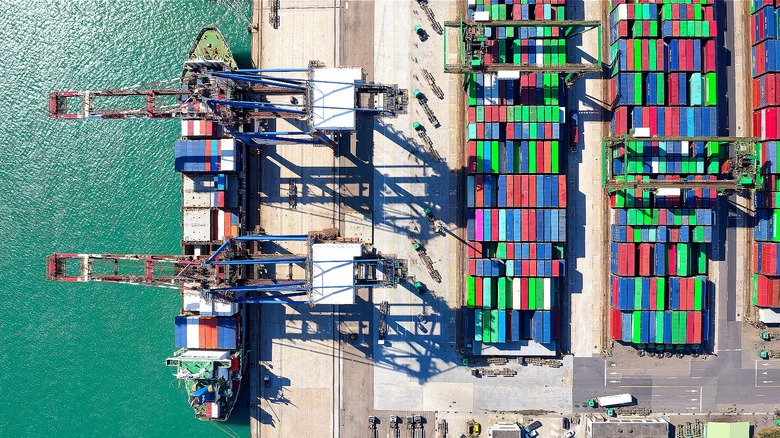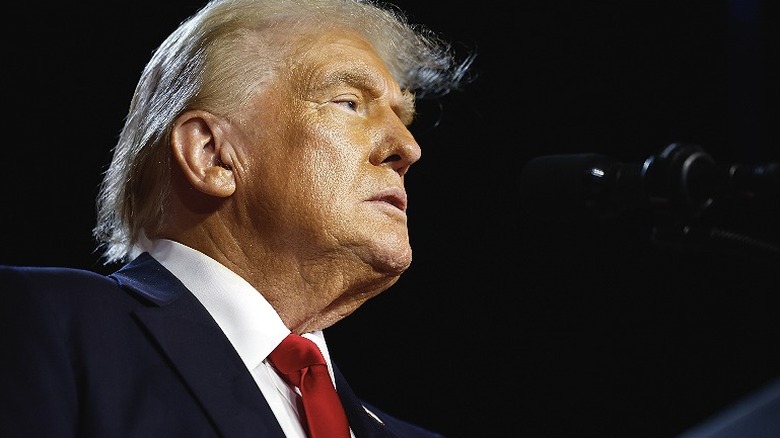What Are Tariffs And Who Pays For Them?
The recent U.S. presidential election was filled with a wide variety of potential economic policies, ranging from which candidate would lower your taxes more to taxation on tips. One concept in particular, tariffs, jumped to the forefront of many economic and political discussions during the course of the election. While you've more than likely heard the tax term thrown around with increasing frequency, you might not have fully understood the implications attached to it. As an economic sticking point for many, and a preferred strategy of President-elect Donald Trump, tariffs are on track to become a significant part of American economics discussions for many years to come.
To go back to basics, tariffs are taxes (also known as customs duties) imposed on imported goods. In the U.S., tariffs function as trade barriers in that they place an additional economic burden on foreign exporters trying to bring their products into the U.S. for consumers. This can effectively reduce the quantity of certain products entering the country, and/or even the quality of that product as importers try to make up the cost difference.
Tariffs ultimately affect the overall production costs of products being imported, which oftentimes means that the manufacturers and exporters responsible for those products end up passing those increased costs on to their consumers. So, while the main motivation for implementing tariffs is supposedly to place greater emphasis on locally sourced products as opposed to imported ones, the actual consequence of tariffs is often instead an increase in prices for consumers on the same products they need and/or already use.
Trump's proposed tariffs
The primary reason the issue of tariffs has been so common in the news in 2024 is due to President-elect Donald Trump's plans to enact extensive tariffs. While it's still unclear what rate Trump might actually enact, on the campaign trail he proposed a blanket 10% to 20% tax on all imports coming into the U.S., with a minimum 60% tariff on imports coming from China. Trump has also offered up the potential of a minimum 200% tariff on all vehicles coming from Mexico, and similar amounts on specific companies that might shift production to Mexico in the wake of his other tariffs.
It's worth mentioning that Trump tried a similar tariff policy in 2018, during his first term in office. However, these tariffs led to another, unintended consequence. Trump initially announced the rollout of these tariffs in July of that year, with the initial 10% tariff going into effect in September before jumping to 25% in January of 2019. This meant importers had very little time to try and get ahead of the incoming duties.
Unfortunately, as importers rushed to move goods into the country before the policy went into effect, ocean freight rates experienced a significant spike in price (Freightos data suggests that ocean freight rates doubled in 2018), followed by an extended period of limited container volume. While, for consumers, this doesn't impact product pricing nearly as much as the actual tariffs do, it's worth noting that it could lead to additional short-term complications and expenses.
Who pays for tariffs?
As previously mentioned, most importers pass on the cost of imposed tariffs directly onto consumers. This then increases the overall cost of domestic sales due to the artificial increase placed on imports. This could lead to a significant increase on all imported goods in the U.S., including products like vehicles, furniture, and pharmaceuticals. This also means that U.S. consumers, who are already battling inflation and, according to Bankrate, have experienced a 21.4% increase in the costs of consumer goods since 2020, could face even worse pricing in 2025, should Donald Trump enact his proposed tariffs.
Even worse, according to the Tax Foundation, the distributional effects of tariffs often disproportionately burden low-income households more so than high-income households, meaning the country's most vulnerable will be especially affected. Another consideration is that businesses could decide to also lower their offered wages to offset the loss of money due to tariffs. This could put consumers in an even tougher financial position than they already were post-pandemic.
The scale of the price increases, and how damaging they could ultimately be for consumers will depend largely on if Trump is able to impose tariffs, and just how high he makes them (in addition to other concerns like Trump's plan for Social Security). As Peter Sand, chief shipping analyst at Xeneta, explained to CNBC, "Raising barriers to trade is almost always a negative move. We saw the cost of shipping goods by ocean spike dramatically when Trump introduced tariffs back in 2018 and his latest proposals will simply be a case of history repeating."


